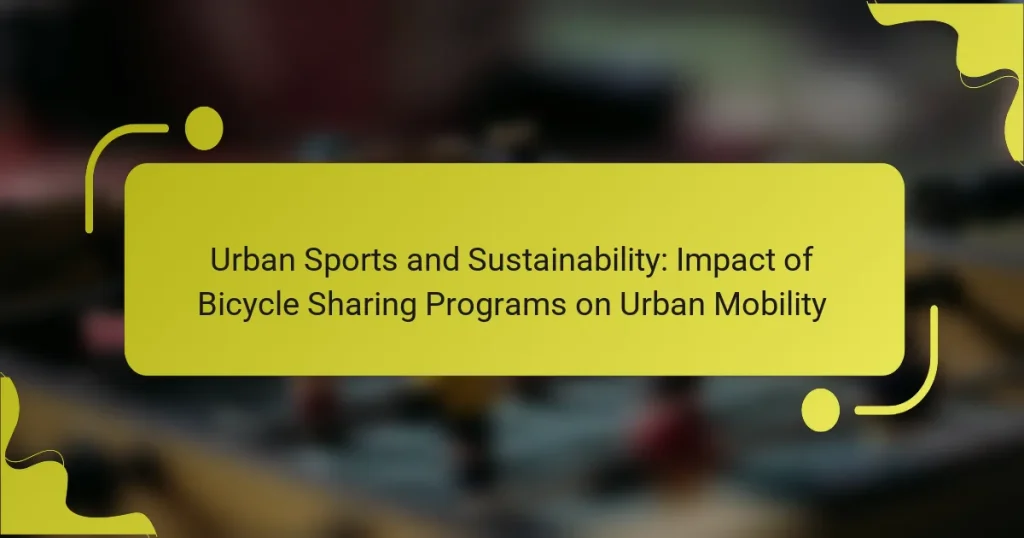Bicycle sharing programs significantly enhance urban sustainability by reducing traffic congestion and lowering greenhouse gas emissions. These systems promote healthier lifestyles and support local economies through increased foot traffic. However, challenges such as infrastructure limitations and user behaviour can impact their effectiveness. This article explores the environmental benefits, economic growth, and strategies for optimising bicycle sharing programs in urban mobility.

How do bicycle sharing programs contribute to urban sustainability?
Bicycle sharing programs enhance urban sustainability by reducing traffic congestion, lowering greenhouse gas emissions, and promoting healthier lifestyles. These systems provide accessible transportation options, encouraging more people to cycle instead of driving.
Studies show that cities with bicycle sharing programs experience a significant decrease in air pollution levels. For instance, a program in Paris led to a 30% reduction in car trips, contributing to improved urban air quality.
Furthermore, these programs support local economies by increasing foot traffic in urban areas. Increased cycling can lead to higher sales for local businesses, fostering community engagement.
In summary, bicycle sharing programs serve as a critical element in advancing urban sustainability through environmental benefits, economic growth, and enhanced public health.
What are the environmental benefits of bicycle sharing?
Bicycle sharing programs offer significant environmental benefits by reducing carbon emissions, minimising traffic congestion, and promoting sustainable urban transport. These programs encourage a shift from car usage to cycling, leading to cleaner air and lower noise pollution.
Bicycle sharing can decrease the number of vehicles on the road, thus reducing greenhouse gas emissions. For instance, a study found that each shared bicycle can replace up to 13 car trips per week. Additionally, these programs contribute to urban green spaces by promoting cycling infrastructure, which often includes bike lanes and parks.
As cities adopt bicycle sharing, they experience improved public health outcomes due to increased physical activity among residents. This shift can lead to decreased healthcare costs related to sedentary lifestyles.
Overall, bicycle sharing enhances urban sustainability by fostering a culture of eco-friendly transportation, thus benefiting the environment and public health.
How do these programs reduce carbon emissions?
Bicycle sharing programs significantly reduce carbon emissions by promoting eco-friendly urban mobility. These programs decrease reliance on personal vehicles, leading to fewer greenhouse gas emissions. Studies show that cities with bike-sharing systems can reduce carbon emissions by up to 50% compared to those without. Additionally, the use of bicycles contributes to lower traffic congestion, which further minimises emissions from idling vehicles. Overall, bicycle sharing fosters a sustainable transportation culture in urban areas.
What role do bicycle sharing programs play in promoting active transportation?
Bicycle sharing programs significantly promote active transportation by providing convenient, accessible, and affordable mobility options. These programs encourage cycling, reduce reliance on motor vehicles, and contribute to improved public health and environmental sustainability.
Studies indicate that cities with extensive bicycle sharing systems see a notable increase in cycling rates, which leads to reduced traffic congestion and lower greenhouse gas emissions. For instance, a study in Washington D.C. found that bike-sharing users were 30% more likely to incorporate cycling into their daily commutes.
Moreover, bicycle sharing enhances urban mobility by integrating with public transportation systems, making it easier for users to complete their journeys. This integration fosters a shift towards more sustainable transportation habits, supporting the overall goal of reducing urban carbon footprints.
In summary, bicycle sharing programs play a pivotal role in promoting active transportation by increasing cycling participation, improving urban mobility, and contributing to environmental sustainability.

What are the key components of successful bicycle sharing programs?
Successful bicycle sharing programs comprise key components such as accessibility, affordability, user-friendly technology, and community engagement. Accessibility ensures bikes are available in high-demand areas, while affordability encourages wider usage. User-friendly technology, including mobile apps for locating bikes, enhances user experience. Community engagement fosters local support and promotes sustainable urban mobility.
Which technologies enhance user experience in bicycle sharing?
Technologies that enhance user experience in bicycle sharing include mobile apps, GPS tracking, smart locks, and data analytics. These tools improve accessibility, convenience, and safety for users.
Mobile apps allow users to locate bikes, check availability, and make reservations easily. GPS tracking provides real-time information on bike locations, enhancing user confidence. Smart locks enable seamless bike access, reducing theft risks. Data analytics help optimise bike distribution and maintenance, ensuring reliability.
How do pricing models affect user adoption?
Pricing models significantly influence user adoption of bicycle sharing programs by affecting perceived value and accessibility. Flexible pricing, such as pay-per-use or subscription plans, can attract a broader user base. For instance, programs offering discounted rates for students or frequent users increase participation. Additionally, transparent pricing structures enhance trust, encouraging users to try the service. A study indicated that cities with diverse pricing options saw a 30% increase in user engagement within the first year. Thus, effective pricing strategies are crucial for maximising urban mobility through bicycle sharing initiatives.
What infrastructure is necessary to support bicycle sharing?
Bicycle sharing requires a network of dedicated infrastructure to operate effectively. Essential components include docking stations for bike storage, maintenance facilities for repairs, and bike lanes to ensure safety. Additionally, digital platforms for user access and payment processing are crucial.
Investing in these infrastructures enhances urban mobility and promotes sustainable transportation options. For example, cities with extensive bike lanes report a 30% increase in bicycle usage. Integrating bicycle sharing with public transport systems further improves accessibility and encourages eco-friendly commuting.

How do bicycle sharing programs impact urban mobility patterns?
Bicycle sharing programs significantly enhance urban mobility patterns by providing accessible transportation options. These programs reduce reliance on personal vehicles, leading to decreased traffic congestion and lower emissions.
Studies show that cities with bike-sharing systems experience a notable increase in cycling rates, which promotes healthier lifestyles among residents. For instance, cities like Copenhagen and Amsterdam have integrated bicycle sharing into their public transit systems, resulting in improved air quality and urban sustainability.
Moreover, bike-sharing programs often target underserved areas, increasing mobility equity. They offer an affordable alternative for short trips, making urban spaces more navigable and connected.
As a result, the implementation of bicycle sharing fosters a shift toward more sustainable urban transport, aligning with global efforts to combat climate change and promote public health.
What changes in commuting behaviour are observed with bicycle sharing?
Bicycle sharing programs lead to significant changes in commuting behaviour, promoting shorter trips and reducing reliance on cars. These programs enhance urban mobility by providing a flexible, eco-friendly transportation option. Studies show that cities with bike-sharing systems experience a decrease in traffic congestion and an increase in cycling rates. Additionally, users often report higher satisfaction and improved health outcomes due to increased physical activity.
How do these programs affect public transport usage?
Bicycle sharing programs significantly increase public transport usage by providing a convenient alternative for short trips. They encourage users to combine cycling with public transport, leading to reduced congestion and lower emissions. Research indicates that cities with bike-sharing systems often see a rise in public transport ridership, enhancing overall urban mobility.
What demographic factors influence participation in bicycle sharing?
Demographic factors such as age, income, and education significantly influence participation in bicycle sharing. Younger individuals, particularly those aged 18-34, tend to engage more in these programs. Higher income levels correlate with increased usage, as individuals can afford membership fees and associated costs. Education also plays a role, with more educated populations showing a greater propensity to utilise bicycle sharing due to awareness of sustainable transport benefits. Urban density further impacts participation, as denser areas provide better access to bicycle stations and routes.

What challenges do bicycle sharing programs face in urban environments?
Bicycle sharing programs in urban environments face several challenges, including infrastructure limitations, user behaviour, and financial sustainability.
Inadequate bike lanes and parking spaces hinder the effectiveness of these programs. Many cities lack the necessary infrastructure to support safe cycling, leading to safety concerns among potential users.
User behaviour presents another challenge. Some individuals may not prioritise cycling, opting for cars or public transport instead. This reluctance can limit the overall adoption of bike-sharing services.
Financial sustainability is crucial for long-term success. Many programs struggle with funding and operational costs, making it difficult to maintain and expand services. As a result, effective strategies are needed to address these challenges and enhance urban mobility through bicycle sharing.
How do theft and vandalism impact program sustainability?
Theft and vandalism significantly undermine the sustainability of bicycle sharing programs. These incidents lead to increased operational costs and reduced bike availability, discouraging user participation. As a result, the overall effectiveness of urban mobility initiatives diminishes, impacting community accessibility and environmental goals. Addressing these challenges is crucial for maintaining program viability and promoting sustainable urban transport solutions.
What are the common operational challenges?
Bicycle sharing programs face operational challenges like system maintenance, user behaviour, and fleet management. These factors impact sustainability and urban mobility.
Maintenance of bicycles is crucial to ensure safety and reliability. Regular inspections and repairs can be resource-intensive. User behaviour, including improper parking and vandalism, can disrupt service efficiency.
Fleet management must balance supply and demand. This involves strategically placing bicycles in high-demand areas while minimising costs. Data analytics can enhance decision-making but requires investment in technology.
Overall, addressing these challenges is essential for the success of bicycle sharing programs in promoting sustainable urban mobility.
How do weather conditions affect user engagement?
Weather conditions significantly influence user engagement in bicycle sharing programs. Factors such as temperature, precipitation, and wind speed affect ridership levels. For instance, warmer temperatures typically increase usage, while rainy or snowy days lead to decreased participation.
Additionally, research indicates that cities with more favourable weather conditions see higher rates of bicycle sharing. A study found that a 1°C increase in temperature can boost ridership by approximately 3%. Conversely, adverse weather can deter users, highlighting the importance of climate in urban mobility strategies.
Engagement also varies by season, with spring and summer months generally yielding higher participation rates. This seasonal trend underscores the need for bicycle sharing programs to adapt their marketing and operational strategies based on weather forecasts to optimise user engagement.

What unique features differentiate bicycle sharing programs across regions?
Bicycle sharing programs differ across regions through unique features such as pricing models, technology integration, and user accessibility. For instance, programs in European cities often utilise docked systems, while North American cities may prefer dockless models.
Additionally, some regions emphasise sustainability through electric bicycles, enhancing urban mobility. User demographics also vary; younger populations may favour app-based access, while older users might prefer traditional membership models.
Regional regulations influence operational hours and service areas, impacting user experience. Lastly, partnerships with local businesses can enhance the value proposition, creating tailored incentives for users.
How do local regulations shape program implementation?
Local regulations significantly influence the implementation of bicycle sharing programs by establishing operational frameworks and safety standards. These regulations can dictate aspects such as parking locations, pricing structures, and the integration of bike lanes. For instance, cities with supportive policies may see increased program adoption, while restrictive regulations can hinder growth. Effective collaboration between local governments and program operators fosters sustainable urban mobility and enhances user experience.
What cultural attitudes influence the success of bicycle sharing?
Cultural attitudes significantly influence the success of bicycle sharing programs by shaping public perception and user engagement. Acceptance of cycling as a viable transportation option fosters participation, while environmental consciousness enhances program appeal.
Cities with a strong cycling culture, such as Amsterdam, demonstrate higher usage rates. In contrast, areas with car-centric mindsets may struggle to integrate bike-sharing effectively. Studies show that public initiatives promoting cycling education and infrastructure improvements can shift attitudes positively, leading to increased adoption and sustained usage.
Community involvement and local advocacy also play critical roles. Successful programs often engage residents in planning and decision-making, fostering a sense of ownership. This collaborative approach can enhance the perceived value of bicycle sharing, aligning it with local sustainability goals.
Which innovative models are emerging in bicycle sharing?
Innovative models emerging in bicycle sharing include dockless systems, electric bike integration, and subscription-based services. These models enhance urban mobility by increasing accessibility and convenience.
Dockless systems allow users to pick up and drop off bikes anywhere, promoting flexibility. Electric bike integration offers an added advantage for longer distances and hilly terrains. Subscription-based services provide users with affordable, long-term access, encouraging consistent use.
As a result, these models contribute to reduced traffic congestion and lower carbon emissions, aligning with sustainability goals in urban environments.

How can cities optimise bicycle sharing programs for better outcomes?
Cities can optimise bicycle sharing programs by enhancing accessibility, integrating technology, and promoting community engagement. Improved accessibility ensures that bike stations are strategically located near high-traffic areas, making them more convenient for users. Integrating technology, such as mobile apps for real-time tracking and payment, can streamline user experience and increase participation. Promoting community engagement through local events and partnerships can raise awareness and encourage more residents to utilise the program. These strategies can lead to increased ridership and reduced congestion, contributing to sustainable urban mobility.
What best practices can enhance user engagement?
Implementing best practices like user feedback integration, gamification elements, and targeted marketing strategies can significantly enhance user engagement in bicycle sharing programs. Engaging users through personalised experiences increases retention rates. For example, offering rewards for frequent usage encourages continued participation. Additionally, clear communication about program benefits fosters community involvement and user satisfaction.
How can data analytics improve operational efficiency?
Data analytics enhances operational efficiency in bicycle sharing programs by optimising resource allocation, improving user experience, and reducing costs. By analysing usage patterns, cities can identify peak demand times and adjust bike availability accordingly. This data-driven approach leads to better maintenance schedules, ensuring bikes are in good condition and readily accessible. Additionally, analytics can inform urban planning, promoting sustainable transport solutions that align with community needs. Ultimately, leveraging data analytics fosters a more efficient, responsive, and sustainable urban mobility system.
What strategies can be employed to increase accessibility?
Implementing strategies to increase accessibility in bicycle sharing programs involves enhancing infrastructure, improving technology, and fostering community engagement.
1. Develop dedicated bike lanes to ensure safe and convenient routes for users.
2. Incorporate adaptive bicycles to cater to individuals with disabilities.
3. Utilise mobile apps that provide real-time information on bike availability and routes.
4. Offer subsidised memberships for low-income residents to encourage usage.
5. Collaborate with local organisations to promote cycling and educate users on bike sharing benefits.
6. Conduct regular surveys to gather feedback and identify accessibility barriers.
What common mistakes should cities avoid when implementing bicycle sharing programs?
Cities should avoid poor planning, inadequate infrastructure, and lack of community engagement when implementing bicycle sharing programs. These mistakes can lead to low usage rates and operational failures.
First, neglecting to assess demand can result in an insufficient number of bikes or stations, limiting accessibility. Second, failing to create safe cycling routes can deter potential users, impacting overall safety and satisfaction. Third, not involving the community in the planning phase may lead to a disconnect between the program and user needs, reducing effectiveness.
Finally, overlooking maintenance and operational logistics can lead to bike availability issues, frustrating users. Addressing these common pitfalls can enhance the success and sustainability of bicycle sharing initiatives in urban environments.




